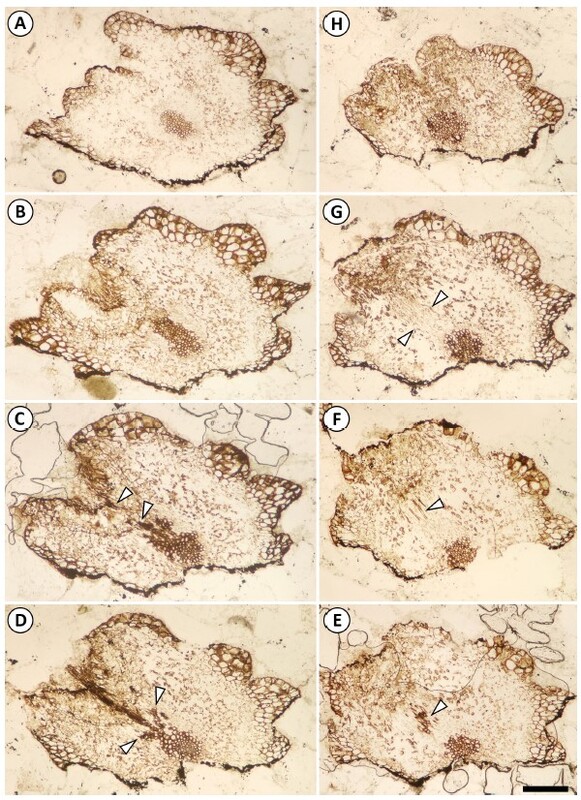ORIGINAL ARTICLE
Trauma in the life of a Nebuloxyla, an Early Devonian basal euphyllophyte
1
Department of Biological Sciences, California State Polytechnic University – Humboldt, Arcata, California
95521, U.S.A.
2
Departamento de Biología, Universidad Autónoma de Madrid, Cantoblanco, Madrid, 28049, Spain
Publication date: 2024-12-31
Acta Palaeobotanica 2024; 64(2): 405-412
HIGHLIGHTS
- The Early Devonian euphyllophyte Nebuloxyla recovered successfully from trauma
- We reconstruct the dynamics of a discrete wounding event that occurred 400 myr ago
- This occurrence demonstrates that even very small early tracheophytes were resilient
- Early euphyllophytes were capable of recovery from trauma affecting the deep tissues
- Early euphyllophytes had evolved complex wound response mechanisms
KEYWORDS
ABSTRACT
Anatomically preserved material from Lower Devonian strata of the Battery Point Formation
(Gaspé Peninsula, Quebec, Canada) offers a rare opportunity to reconstruct the sequence of events in the life
of a Nebuloxyla mikmaqiana plant (early euphyllophyte) that led to wounding and the plant’s recovery after
wounding. Using serial sections from cellulose acetate peels of the Nebuloxyla axis and volume renderings of the
affected tissues, we show that the wound, centered around a branch and caused likely by an herbivore, resulted
in removal of the extraxylary tissues of the branch starting from its very base, associated with bending of the
xylem strand that supplied the branch. Downward bending of the branch xylem toward the base of the main
axis led to the separation and displacement of a significant portion of it, leaving a short portion of the xylem
strand at the base of the branch in its original position. The displaced strand of branch xylem, after stripping
of the extraxylary tissues along with some of its own thickness, was left protruding outwards from the open
wound surface. Subsequent development of wound response tissue filled the gap left by the wound around the
protruding displaced xylem strand, surrounding it with wound periderm. This specimen provides evidence that
plants as old as Nebuloxyla had the capacity to endure and survive traumatic events, and to deploy effective
and sophisticated response mechanisms that had already evolved in the euphyllophyte clade by Emsian time.
More broadly, this occurrence re-emphasizes the importance of permineralized fossils in documenting details
of plant anatomy and development, even allowing glimpses into minutia of their daily life, such as interactions
with their environment and immediate responses to these interactions.
FUNDING
MAKL’s research is supported by a U.S.
National Science Foundation Graduate Research Fellowship
(#000922334).
REFERENCES (15)
1.
Banks, H.P., 1981. Peridermal activity (wound repair) in an Early Devonian (Emsian) trimerophyte from the Gaspé Peninsula, Canada. The Palaeobotanist 28, 20–25. https://doi.org/10.54991/jop.1....
2.
Banks, H.P., Colthart, B.J., 1993. Plant–animal–fungal interactions in Early Devonian trimerophytes from Gaspé, Canada. American Journal of Botany 80, 992–1001. https://doi.org/10.1002/j.1537....
3.
Bickner, M., Tomescu, A.M.F., 2019. Structurally complex, yet anatomically plesiomorphic: permineralized plants from the Emsian of Gaspé (Quebec, Canada) expand the diversity of Early Devonian euphyllophytes. IAWA Journal 40, 421–445. https://doi.org/10.1163/229419....
4.
Cohen, K.M., Finney, S.C., Gibbard, P.L., Fan, J-X., 2013. The ICS International Chronostratigraphic chart. Epi-sodes 36, 199–204. Updated 2020.
5.
Fedorov, A., Beichel, R., Kalpathy-Cramer, J., Finet, J., Fillion-Robin, J-C., Pujol, S., Bauer, C., Jennings, D., Fen-nessy, F.M., Sonka, M., Buatti, J., Aylward, S.R., Miller, J.V., Pieper, S., Kikinis, R., 2012. 3D Slicer as an image computing platform for the quantitative imaging network. Magnetic Resonance Imaging 30, 1323–41. https://doi.org/10.1016/j.mri.....
6.
Hoffman, L.A., Tomescu, A.M.F., 2013. An early origin of secondary growth: Franhueberia gerriennei gen. et sp. nov. from the Lower Devonian of Gaspé (Quebec, Canada). American Journal of Botany 100, 754–763. https://doi.org/10.3732/ajb.13....
7.
Hueber, F.M., Banks, H.P., 1967. Psilophyton princeps: the search for organic connection. Taxon 16, 81–85. https://doi.org/10.2307/121688....
8.
Joy, K.W., Willis, A.J., Lacey, W.S., 1956. A rapid cellulose peel technique in botany. Annals of Botany 20, 635–637. https://doi.org/10.1093/oxford....
9.
Kenrick, P., Crane, P.R., 1997. The origin and early diversification of land plants: a cladistics study. Washington, DC, USA, Smithsonian Institution Press.
10.
Kevan, P.G., Chaloner, W.G., Savile, D.B., 1975. Interrelationships of early terrestrial arthropods and plants. Palaeontology 18, 391–407.
11.
Kidston, R., Lang, W.H.,1921. On old red sandstone plants showing structure, from the Rhynie chert Bed, Aber-deenshire. Part V. The Thallophyta occurring in the peatbed; the succession of the plants throughout a vertical section of the bed, and the conditions of accumulation and preservation of the deposit. Transactions of the Royal Society of Edinburgh 52, 855–902. https://doi.org/10.1017/S00804....
12.
Lalica, M.A.K., Tomescu, A.M.F., 2023. Complex wound response mechanisms and phellogen evolution – insights from Early Devonian euphyllophytes. New Phytologist 239, 388–398. https://doi.org/10.1111/nph.18....
13.
Long, B.K., Ruehrwein, R.J., Tomescu, A.M.F., 2022. Correcting the sizes of fossil features measured in cellulose acetate peels for drying-related peel shrinkage. Review of Palaeobotany and Palynology 305, 104750. https://doi.org/10.1016/j.revp....
14.
McGregor, D.C., 1977. Lower and Middle Devonian spores of eastern Gaspé, Canada. II. Biostratigraphy. Palaeontographica Abt. B 163, 111–142.
15.
Toledo, S., Bippus, A.C., Atkinson, B.A., Bronson, A.W., Tomescu, A.M.F., 2021. Taxon sampling and alternative hypotheses of relationships in the euphyllophyte plexus that gave rise to seed plants: insights from an Early Devonian radiatopsid. New Phytologist 232, 914–927. https://doi.org/10.1111/nph.17....
Share
RELATED ARTICLE
We process personal data collected when visiting the website. The function of obtaining information about users and their behavior is carried out by voluntarily entered information in forms and saving cookies in end devices. Data, including cookies, are used to provide services, improve the user experience and to analyze the traffic in accordance with the Privacy policy. Data are also collected and processed by Google Analytics tool (more).
You can change cookies settings in your browser. Restricted use of cookies in the browser configuration may affect some functionalities of the website.
You can change cookies settings in your browser. Restricted use of cookies in the browser configuration may affect some functionalities of the website.



